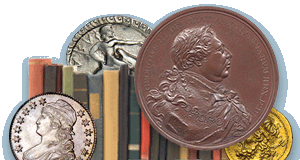
PREV ARTICLE
NEXT ARTICLE
FULL ISSUE
PREV FULL ISSUE
MOTHER'S DAY NUMISMATICSE-Sylum readers love history, and I thought I'd first share this interesting background on Mother's Day from Garrison Keillor's Writer's Almanac. -Editor
It's the second Sunday in May, which is Mother's Day here in the United States. It's Mother's Day in other countries, too, including Denmark, Italy, Venezuela, Turkey, Australia, and Japan. A woman named Anna Jarvis was the person behind the official establishment of Mother's Day. Her mother, Anna Reeves Jarvis, had a similar idea, and in 1905 the daughter swore at her mother's grave to dedicate her life to the project. She campaigned tirelessly for the holiday. In 1907, she passed out 500 white carnations at her mother's church, St. Andrew's Methodist Episcopal Church in Grafton, West Virginia — one for each mother in the congregation. In 1912, West Virginia became the first state to adopt an official Mother's Day, and in 1914 President Woodrow Wilson made it a national holiday. Anna Jarvis became increasingly concerned over the commercialization of Mother's Day. She said, "I wanted it to be a day of sentiment, not profit." She was against the selling of flowers, and she called greeting cards "a poor excuse for the letter you are too lazy to write." Nevertheless, Mother's Day has become one of the best days of the year for florists. When Anna Jarvis lived the last years of her life in nursing home without a penny to her name, her bills were paid, unbeknownst to her, by the Florist's Exchange. Getting to the numismatics of this day, I thought I'd share a Pocket Change blog by Matthew Wittman of the American Numismatic Society that we excerpted back in 2015. Happy Mother's Day, Moms! -Editor With Mother's Day approaching this weekend, I thought it might be a good time for a post about the many mothers who appear in the collection of the American Numismatic Society. The most common way mothers figure in our collections is via medallic art, where prominent artists ranging from Oscar Roty (1846-1911) to Victor David Brenner (1871-1924) engraved medals depicting maternal ideals. Roty's particularly elegant medal was executed as a memorial of the baptism of his son in 1893. Brenner's medal follows Roty rather closely and indeed much of the medallic art concerning motherhood in the Beaux-Arts era traded in these kind of sentimental images. One exceptional item to note in this context is a wonderful medallion by Adam Pietz (1873-1961) that depicts his own mother in a realistic rather than an idealized fashion. (I should also note that the ANS has a small archive of his drawings, photographs, and papers.) In 1914, a proclamation by Woodrow Wilson officially set aside the "second Sunday of May as a public expression of our love and reverence for the mothers of our country." He did so as a result of long-running campaign by activist Anna Jarvis to honor the memory of her own mother and the ideal of motherhood more generally. The holiday subsequently spread around the world, in some places combining with existing traditions. Mother's Day took on a special significance in the context of World War I when so many mothers had sons fighting and dying overseas. See the Art of Devastation project for the many ways that mothers featured in the often grim medallic art and propaganda that accompanied the war. Here's a non-medallic item we didn't excerpt earlier. I also added images of the Brenner medal above which was linked but not pictured in the ANS blog article. -Editor On the other hand, mothers have appeared only very sparingly in circulating currency. While there is a lot of Byzantine and medieval coinage that features religious iconography of the Virgin Mary with child, more specific and secular representations of motherhood have been few and far between. A notable exception to this rule was the Obsolete Bank Note Era (1782-1866) in the United States, when images of mothers and childhood proliferated. This was not coincidentally a time when modern ideas about childhood and the nurturing role of the mother in particular were coming to the fore.
To read the complete article, see:
To read the Writer's Almanac article, see:
To read the earlier E-Sylum article, see:
Wayne Homren, Editor The Numismatic Bibliomania Society is a non-profit organization promoting numismatic literature. See our web site at coinbooks.org. To submit items for publication in The E-Sylum, write to the Editor at this address: whomren@gmail.com To subscribe go to: Subscribe All Rights Reserved. NBS Home Page Contact the NBS webmaster 
|





